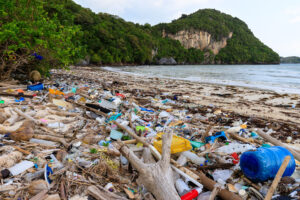
Researchers develop process to recycle thermoset plastics
Canadian Plastics
Plastics Processes Recycling Research & DevelopmentA team at Case Western Reserve University has developed a new technology that could transform non-recyclable plastics into recyclable ones and reprocess them into new products with comparable or even higher value.

Photo Credit: Stéphane Bidouze/Adobe Stock
They may sound similar, but thermoset and thermoplastics are actually two very separate materials, differentiated by their behaviour when reacting to the application of heat. In a nutshell, thermoset is a material that strengthens when heated, but can’t be remolded or heated after the initial forming; while thermoplastics can be reheated, remolded, and cooled as necessary without causing any chemical changes. Which means that thermoset polymers – which are often used in wind-turbine blades, auto parts, boats, and other mechanically strong and lightweight applications – are single-use and not recyclable in any meaningful way.
Which is not exactly a plus in today’s recycling-obsessed world.
But that may change now that researchers at Case Western Reserve University, located in Cleveland, Ohio, have developed a new technology that could transform non-recyclable plastics into recyclable ones and reprocess them into new products with comparable or even higher value.
Leading the research and development is Ica Manas-Zloczower, Distinguished University Professor and the Thomas W. and Nancy P. Seitz Professor of Advanced Materials and Energy in Macromolecular Science and Engineering; and Liang Yue, a post-doctoral researcher in Manas-Zloczower’s lab.
Manas-Zloczower and Yue have found a new way to take the previously rigid thermoset plastics and break them down into a resin that can be used to remake the product, or make an entirely new product-just as with the softer thermoplastics.
“Many of the plastic commercial products we use are thermoplastic and are already easy to process, but the thermoset materials in construction, aerospace, aircraft, and automobiles are the problem,” Yue said. “These are strong materials and resistant to impact, but until now they were single use. We’re trying to change that.”
What makes thermoset plastics resistant to heat, corrosion, and other environmental factors in the first place is a strong chemical cross-linked molecular network – but this same strength also makes them far more difficult to break down and recycle. Manas-Zloczower and Yue are tackling this problem by converting permanent, cross-linked structures into dynamic cross-linked ones. The dynamic cross-linked network allows reshaping and reprocessing by conventional methods, such as hot-press molding or injection molding, to fabricate a new product with comparable or better value.
Yue began working on the concept in Manas-Zloczower’s Case School of Engineering lab in 2018, using a solvent-assisted approach to diffuse the appropriate catalyst into epoxy and polyurethane networks. They call the new process “vitrimerization” because it converts the thermoset plastics into a new class of materials known as vitrimer polymers, which can be reformed and reprocessed.
To date, Yue has performed the experiment with small amounts of material in the lab. But he and Manas-Zloczower are in discussions with industrial partners about using a process known as “mechanochemical ball-milling” to produce tons of reusable powder resin, with no solvent involved – which makes the process much easier to “scale up in a meaningful way,” Yue said. “We can recycle tons of epoxy waste in a matter of hours now. Initially, with a catalyst and solvent, even at smaller scale, it took much longer.”
The work was funded in part by the National Science Foundation, and Manas-Zloczower and Yue are working closely with the Great Lakes Energy Institute and Case Western Reserve’s Office of Technology Transfer to identify potential industry partners, research funders, or investors to take the next steps toward fully testing the process at industrial scale.
Source: Case Western Reserve University
